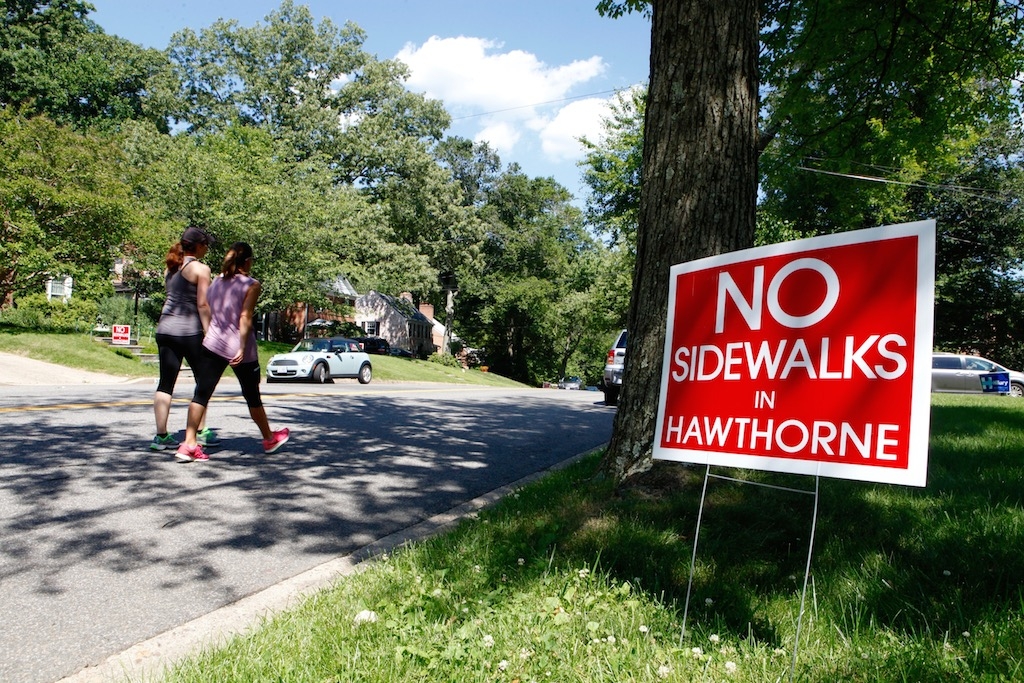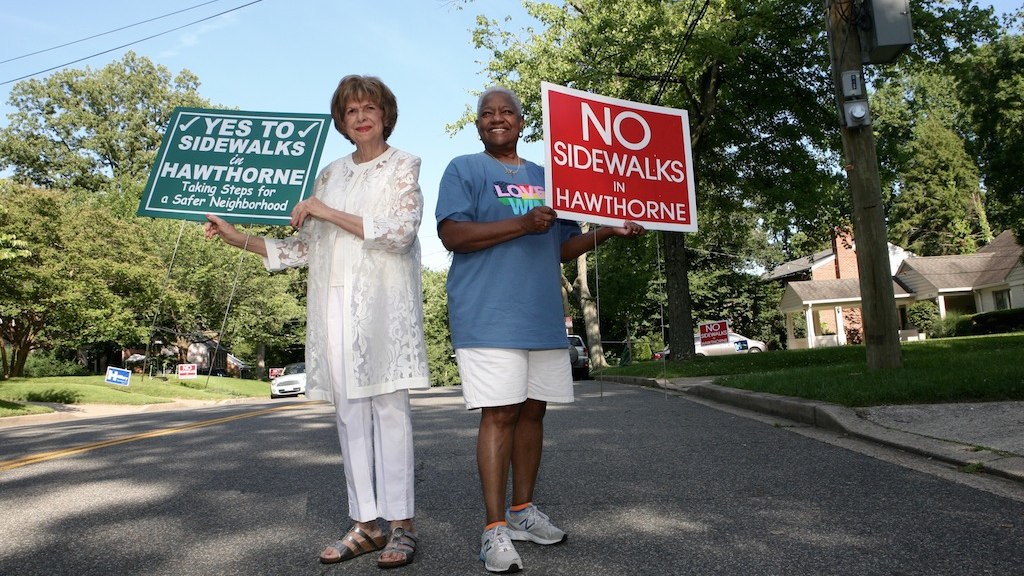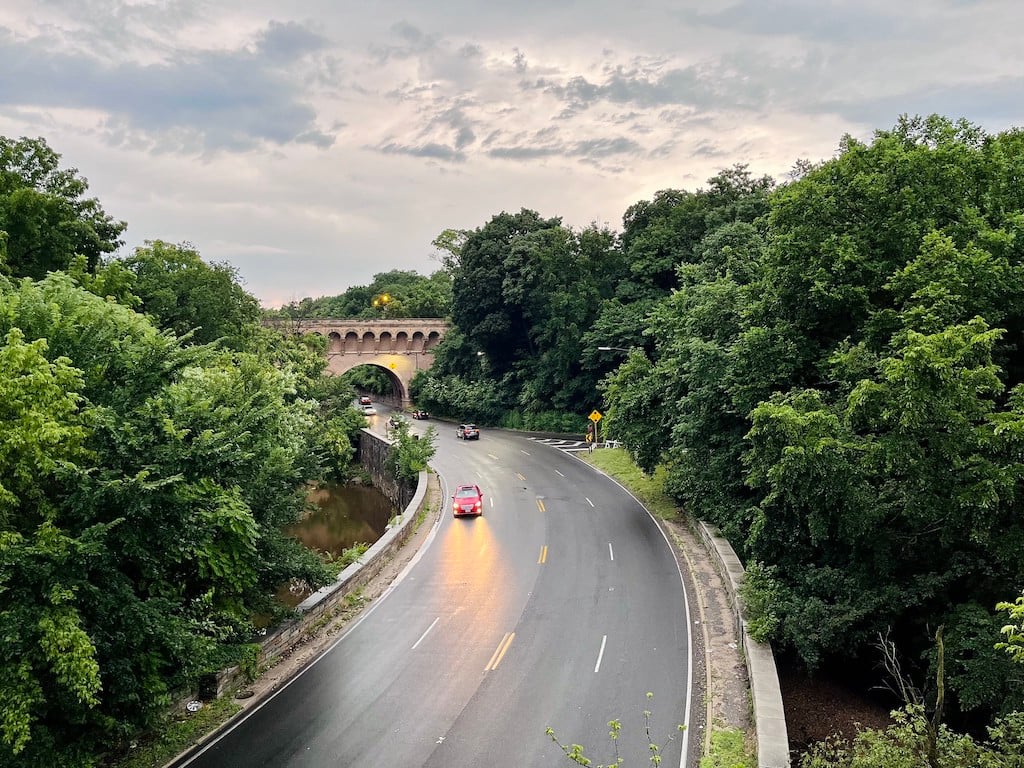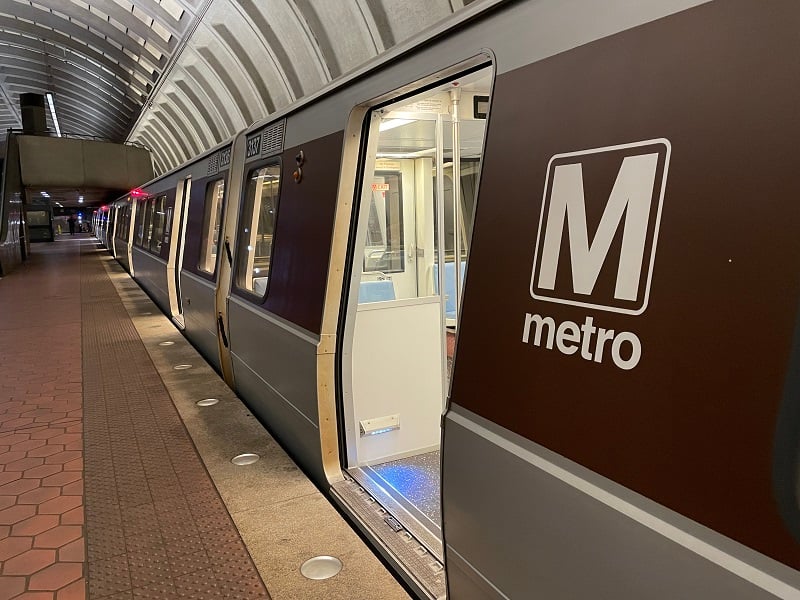Everett Lott knew the bombs were falling on Chestnut Street when his neighbor offered some advice: “Don’t talk to me about sidewalks or I’ll bust your ass.” Remarks like this have been flying all over Lott’s usually tranquil neighborhood of Hawthorne, in Northwest DC: a salty comment from one house, a nasty accusation from across the street. One neighbor, rumor has it, tried to punch another in the face. “I was shocked that someone would say something like that to me,” says Lott. “Over a sidewalk.”
Yes, a sidewalk. Most streets in Hawthorne don’t have them–a rarity in DC–but in the past few months, a new push to install sidewalks in the quiet, tree-lined neighborhood has resulted in a virtual war between factions of residents and the District Department of Transportation (DDOT). Emotions run highest on Chestnut, Hawthorne’s central thoroughfare, where green signs in favor of sidewalks and red signs protesting them now adorn nearly every front yard.
If you’ve never heard of Hawthorne, you’re not alone. The Upper Northwest neighborhood of roughly 250 homes abuts Maryland’s Chevy Chase and is cut off from the rest of the District by Rock Creek Park to the east and the thin sliver of Pinehurst Parkway to the south. Despite its District Zip code, Hawthorne’s ubiquitous oak trees and large, manicured lawns give it a suburban feel. It hardly comes off as the kind of place where neighbors throw punches and threaten to bust one another’s asses. And if you’ve never heard of anyone getting this worked up about sidewalks, you’re also not alone. The issue’s already been decided on the 95 percent of DC streets that have them, and though DDOT has seen some resistance before, it’s safe to say no neighborhood has caused a commotion quite like Hawthorne. UCLA professor Anastasia Loukaitou-Sideris, a sidewalk savant who wrote the first book-length treatise on the subject, says Hawthorne is the first neighborhood she’s seen to rebel against sidewalks so loudly.

When DDOT staffers arrived in the neighborhood a few months ago with suggestions for the Chestnut Street sidewalk, they unwittingly mobilized old battle lines that date back to 2009, when Hawthorne underwent its first “sidewalk war.” At issue was then Mayor Adrian Fenty’s new law that required sidewalks on every pedestrian-accessible street in DC. The plan called for 200 miles of sidewalk installation throughout the District, including Hawthorne.
The law was a shock to a neighborhood where front yards have long been thought of as private, not public, space. Residents argued that sidewalks would fundamentally change the character of Hawthorne, which was developed in the 1940s in typical suburban style: wide roads, big yards, no commercial streets, no sidewalks. As part of the DC region with the thickest tree canopy in the city, Hawthorne’s residents worried that building sidewalks would mean killing the beautiful old trees–chestnut, beech, dogwood–for which the neighborhood’s streets are named. In 2009, Hawthorne protested so vocally that DDOT allowed residents of each block to choose whether or not they wanted sidewalks. Eventually, sidewalks were installed on Beech and a few other streets, while the rest, including Chestnut, were allowed to go sidewalk-less.
Most Hawthorne residents who publicized their opinions in 2009 were in the anti-sidewalk camp, and after the block-by-block decision by DDOT, everyone figured the debate had been put to rest. But in early 2015, a few policy changes put Hawthorne back on the warpath. Mayor Muriel Bowser annouced Vision Zero, an initiative to promote pedestrian and bike safety, and Councilmember Mary Cheh tweaked DDOT’s policy to make it easier for residents to petition in favor of sidewalks.

This time, the pro-sidewalk residents found their voice. Many of them had moved to Hawthorne around the time of the first war, and had seen the red signs while touring the neighborhood with their realtors. “We knew it was controversial,” says Lott, who arrived in late 2009. “So we kept our opinions to ourselves.” Six years later, many of them have young children, whose safety has become a concern. They point to increased traffic on Chestnut Street, which commuters use as a shortcut to Rock Creek Park. Chestnut is also along a bus route, and the sidewalk proponents argue that the numerous maids and gardeners who work in the upper middle class neighborhood need a safe way to walk to and from the bus. (As she walked down the street a few days ago, one person who works as a maid indicated to Washingtonian that she would love a sidewalk.) The law is the law, the proponents say, and DDOT has a responsibility to implement it. “We’re in the nation’s capital,” Cindy Wade, a vocal sidewalk advocate on Chestnut, says incredulously. “And we’re arguing about sidewalks?”
Wade, Lott, and several others knocked on doors on Chestnut Street, assembled a petition of 15 signatures, and submitted it to DDOT last summer. After nine months of conference calls with the proponents, DDOT organized a community meeting to propose a Chestnut sidewalk and discuss what it would take to build. The proponents, along with many anti-sidewalk veterans of the 2009 kerfuffle, gathered in the Chevy Chase Community Center on April 18. In order to build the sidewalk, the crowd was told, DDOT would need to rip out 29 trees and cut as much as 15 feet into front yards. According to Hawthorne residents, DDOT said it would be the most expensive sidewalk in DC.
The department might as well have told Chestnut Street it was going to kill every firstborn child. The reaction was vitriolic, and everyone felt blindsided. The sidewalk opponents had assumed the fight was over in 2009, and felt betrayed to learn their neighbors had been in talks with DDOT for months. “It hurt,” one detractor recalls. The proponents felt DDOT had undermined their efforts by arriving with an outrageous, poorly researched plan–“a slash-and-burn,” as one advocate called it. DDOT, for its part, seemed to have forgotten the 2009 debacle. When asked to comment on the meeting, DDOT responded that it felt “the community was generally pleased with the outcome of the meeting.” But that night, neighbors expressed something other than pleasure when they resurrected their lawn signs, drawing the battle lines again.

At the heart of problem is the confusing policy itself, and DDOT’s uneven enforcement of it. The policy lists many things that could justify a sidewalk–school areas, bus stops, petitions–but doesn’t make it clear how these stack up to vocal community antipathy. Though residents can petition for a sidewalk, it’s not clear how many need to be on board. The policy includes a list of vague reasons why a neighborhood might be exempt from sidewalks, but none definitively apply to Hawthorne. Sensing catastrophe, DDOT has since backed away from its April plan and seems to be improvising its way through the policy, an approach that has resulted in many mixed messages. “Our goal in all such efforts is to have a transparent process that ensures the concerns of residents are heard,” DDOT spokesperson Terry Owens tells Washingtonian. “The law on sidewalk installations was recently updated and we are working to ensure that our staff adheres to the new regulations.”
Opponents say some DDOT staffers have promised the Chestnut sidewalk will never happen, though officially the department is still putting together a design. Hawthorne has sent DDOT so many petitions–both pro and con–that many neighbors claim the agency has pleaded for no more. (Owens says, “Petitions are still accepted, but decisions on sidewalk installation are based on the council criteria and budget availability.”) Proponents have written to numerous politicians, all of whom wisely kept their names out of the debate in the leadup to June’s primary election.
For now, facing this mess of direct democracy, Hawthorne is left with a war of attrition. A visit to any house in the neighborhood tends to result in an impromptu living room summit with like-minded neighbors from around the block–Sidewalk War II has brought people closer, if only within their respective camps. In an attempt to lighten the mood, a group of sidewalk opponents in one living room starts to sing Joni Mitchell’s “Big Yellow Taxi,” with a slight alteration: “Don’t it always seem to go, that you don’t know what you’ve got till it’s gone, they paved paradise and installed a sidewalk…”
The attempt at comity works, but only for a few minutes. Residents on each side say they experience slights from the other, like averted eyes and turned heads on evening walks down Chestnut. Each group of neighbors sees something different when they look out their doors, and there’s much they’ll never agree on. Do they notice the weekday mornings when Chestnut Street is busy, or do they notice the weekend afternoons without a car in sight? What keeps them up at night: the thought of their kids getting hit, or the image of their favorite tree being ripped from their yard? Do they dwell on consequences of a sidewalk, or the potential consequences of an absent one?
A block away from Chestnut, the residents of Beech Street have been living with their sidewalk since 2009, when DDOT gave it to them under Fenty’s law. Beech Street provides a glimpse into what lies in store for Chestnut if it’s given a sidewalk, and the picture looks pretty peaceful. Carolyn Seitz, a longtime Beech resident, says she and her neighbors have largely forgotten their differences since the sidewalk was installed. Children still play in the street, and people don’t use the sidewalk a whole lot–but sometimes they do, and it’s nice. For the most part, the world has kept turning.













